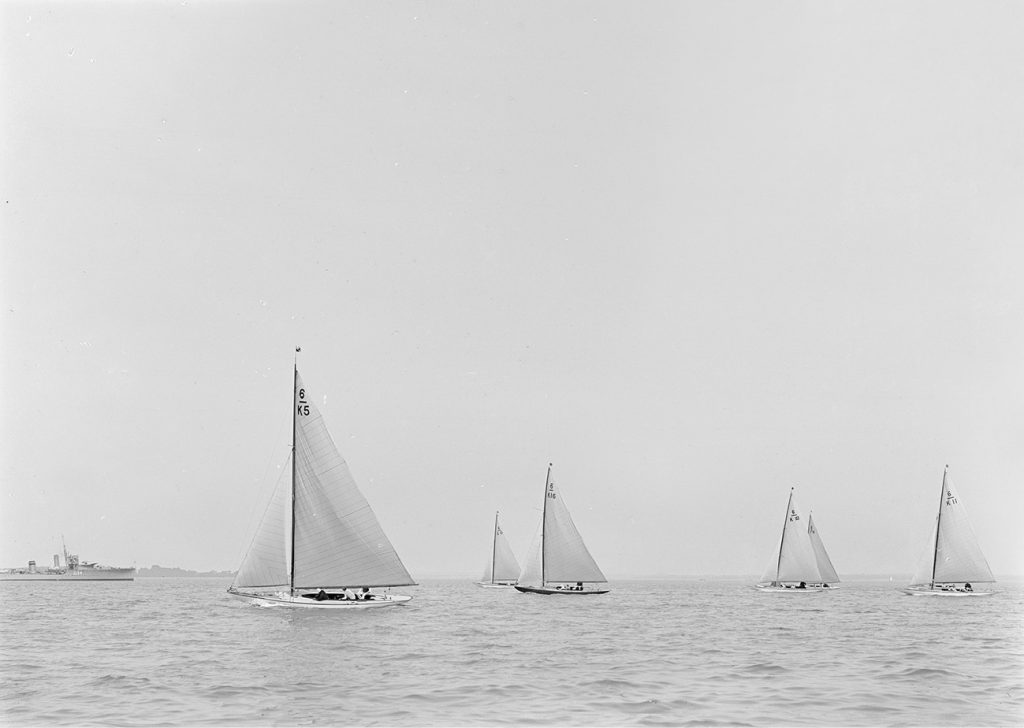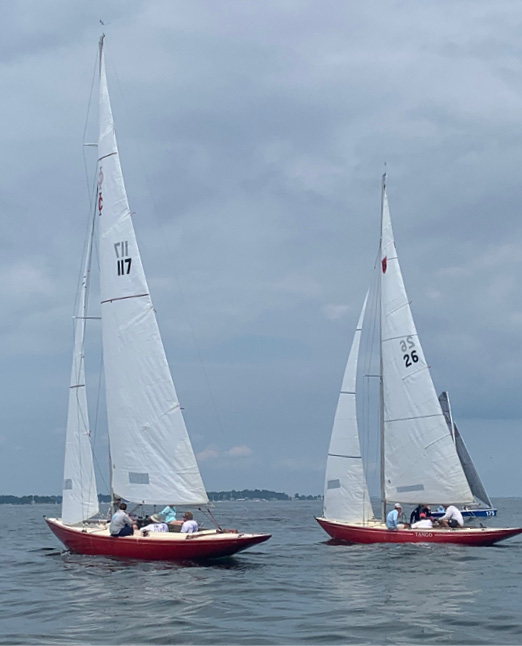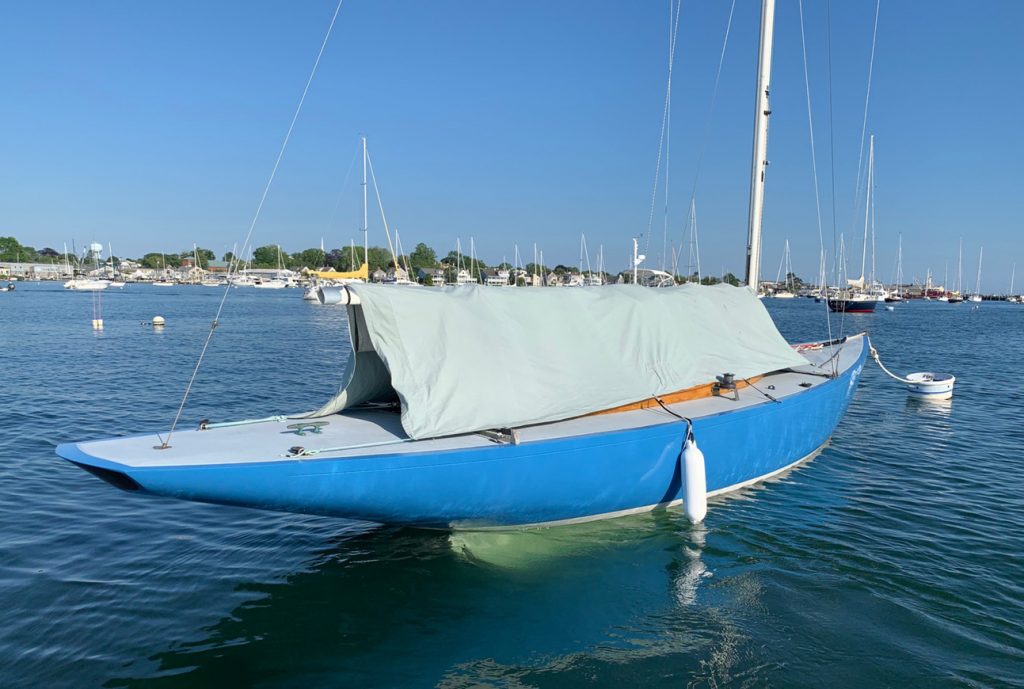In the spring of 2021, we embarked on a four-episode podcast tracing the development of the International Six Metre Class. The hubs of that furious design and competitive scene were Seawanhaka Corinthian and Larchmont Yacht Clubs in New York. The sailing characters included Briggs Cunningham, Herman Whiton, and many future 12 Metre skippers. We still get podcast listener comments today on those episodes; Sixes stories abound.
The drama of the competition played out between designers young and old, a teenage Olin Stephens mentored by Clinton Crane. It featured teams anchored by helmsmen like Olin and Briggs. This was the stuff of high-performance competition. The machines and their crews were awe-inspiring. Even today, any sailor in the presence of a Six is at a loss for words.
In our spring 2021 articles and podcast episodes, you may remember photos of early designs from the 1920s. These boats were the product of fifty years of development under the Seawanhaka and International design rules. A fleet picture shows state-of-the-art Sixes at Cowes, England in the early 1920s. The solo shot shows an American Six of that time, Madcap, which sits today restored in Oyster Bay. After World War I, designers in America and Europe had created a Six Metre sailing scene similar to that of Formula One auto racing today. A series of local and international events, the British American Cup, the Gold Cup, had American and European Six owners crisscrossing the Atlantic. The International One Design (IOD) was the 1930s product of all that innovation
Every year, the IOD class collects its elite to race in the boats of a host fleet. The IOD Worlds rotates between the home waters of the eight major fleets of this one-design Six. This month, that venue would be Fishers Island, that current-enveloped and wind-swept geological outpost south of Connecticut but still inexplicably belonging to New York. This is the fourth Worlds for that little island.
Our guide for the event is Jonathan Farrar, multiple World Champion and co-chair of the 2022 Worlds along with the PRO of the event, Bill Reed. Jonathan’s background is that of the Southeastern Connecticut circuit, land of MudRatz, perhaps the best name ever for a local group of junior sailors. Unknown to many, the region has turned out Olympic sailors like Erin Maxwell and Jonathan’s wife, Isabelle Kinsolving Farrar, both 470 representatives on the US Sailing Team.
Jonathan is the sailing coach for Northeastern University, among other maritime responsibilities on Fishers Island and off. For the Farrars, IODs are a family affair. Jonathan’s father, Kevin Farrar, is one of the sailmakers for the IOD class and supplies the local FIS fleet (I sailed with Kevin in the 2011 IOD North Americans to a memorable win that is certainly one of my sailing highlights.). Kevin was Worlds Champ in 2004, with Jonathan crewing.
Jonathan has been part of five Worlds IOD Championships teams; two as crew, three as skipper. His second crewing gig was for Marblehead’s Bill Widnall, who has the record for most Worlds won. Jonathan, along with former Worlds winners like John Burnham, former editor of Sailing World and Charlie Van Vorheis, a transplant to Fishers from New Bedford, do battle for top dog in the Fishers Island fleet from July 4th to Labor Day.
The IOD: Six Metre Child of the ‘30s

English 6 Metres racing off Cowes, 1921
The IOD is in fact a mid -1930s repackaging of a famous Bermuda-owned, Norwegian-built design of Byrne Aas, the Scandinavian designer and builder of Metre boats. That Six Metre was called Saga, and she caught the eye of one Cornelius Shields, Senior, who had been given the responsibility of sourcing a new class for his Larchmont Yacht Club peers to replace their aging fleet of Sound Interclubs, another slightly smaller keelboat class.
The IOD’s creation story was all about Corny Shields. The Larchmont members wanted bigger, better, taller, more length, stronger construction, and higher mast height. The IOD story is a case study of the boat design process and fleet promotion championed by Shields.
The well-researched detail of the IOD birth is contained in the excellent book done by the IOD class, The Saga of the International One Design: A Celebration of 75 Years. This beautiful book was created for the 2011 75th Jubilee for the class. On pages 22 to 25 is the short form of the creation story of the IOD, and I quote from it liberally.
Byrne Aas and the IOD

The two red cousins: an IOD (left) and a Shields
The story of Saga and Byrne Aas put the spotlight on a Norwegian waterman who was relatively unknown on the American side of the Atlantic. He was very well known in Northern Europe.
“During the 1920s and early 1930s he had designed and most often built as well, several winning 6 Metres and 8 Metres. His two 12 Metres built to the First International Rule, were both designed and built earlier, in 1914.”
“His prominence as a successful racing yacht designer really began in 1924, when his 6 Metre Elizabeth V won the Gold Medal at the Olympic Games (E V is still sailing in the Pacific Northwest, when none other than Dennis Conner chartered her for a winning Worlds bid in the late 2010s). More successful 6 Metre designs followed, one which was Elizabeth VI, Flaks and of course, the IOD’s progenitor, Saga.”
Corny Shields and the IOD
Saga was reincarnated into the International One Design with Shields’ supervision.
“Shields had formed a syndicate with his brother Paul and four other friends in order to underwrite the order for the initial twenty-five boats. Aas could start production immediately while the syndicate promoted and sold the IODs to the rest of the Sound Interclub owners. It was Paul Shields, incidentally, who named the new class the International One Design.”
In the depths of the Depression of the 1930s, Shields put Aas through his design paces and made him earn the right to build a long string of IODS. Design changes are the bete noire of any marine architect. Long Island Sound sailors wanted a taller rig and a shorter boom for the fickle winds of Western Long island Sound.

The latest addition to the Fisher Island YC IOD fleet, Etisian is a 1959 woodie brought from Oyster Bay and redone by a Stoningon, CT syndicate of ex J,70 sailors.
Although the design never underwent sea trials, the feeling was the boat needed at least 100 pounds more ballast. Cockpit size and portholes in the coach roof were another subject of debate. Shields wanted the cabin top porthole shorter to open up a larger racing cockpit. In the end, Aas got the order; and anticipating a big-ticket buy from America, he could afford to bid low.
“No domestic builder could match the proposed price for an IOD: $2,670.00, including spars, all standing and running rigging, sails, cradle, insurance and shipping (approximately $50,000 in 2012 dollars).”
“By the spring of 1937 he (Aas) had as many as sixty employees on the payroll (in Norway)…and had delivered twenty-five IODs to the Long Island Sound fleet, another six to Bermuda, as well as at least nine to form a local fleet in Oslofjord. Orders were received from the Royal Corinthian YC, on the River Crouch in the United Kingdom, and in the United States. Sailors from Marblehead, Massachusetts and Northeast Harbor, Maine decided to join what promised to become an exciting new one-design class.”
Building in his new facility on the island of Isergran in Frederikstad, Aas churned out boats – forty-two in 1937.
“Twenty-one boats were shipped to New York, to make up the complement of twenty-five boats ordered by the Long Island sailors for spring delivery, with two more boats shipped later that summer to replace the two damaged in transit. Of the remaining fifteen, six were delivered to owners in Bermuda and the rest remained in Norway.”
By the summer of 1937, the IOD was established as the premier racing class on Long Island Sound.
The Legacy of the IOD
Watching the Netflix series on the Formula One circuit, “Drive to Survive,” I thought of an Episode Six for the Sixes Series, highlighting the Grand Prix Sixes racing of today that I thought would be the World Championships of the International One Design. At 33 feet, 6 inches and 7,250 pounds displacement, with a cloud of sail, the IOD was the Formula One car of its time. It required an experienced driver and a disciplined crew. Nothing has changed since the 1930s in this class of competitive one-design Six Metres.
Look at the sailing legacy of the 1930s and the IOD. The revival of the America’s Cup in 1958 included not only the Godfather of IODs himself, Corny Shields but a virtual Who’s Who of IOD sailors steering those Twelves in an unbroken string of successful defenses. Other 12 Metre stalwarts brought up on the IOD were Arthur Knapp, Jr. (who had been part of the J Class Ranger’s afterguard), Bill Luders, Bob Bavier, Briggs Cunningham, Bus Mosbacher, and from the Marblehead Fleet, Don McNamara and Ted Hood.
Sailing in July 2022 at Larchmont Race Week in a small but keen IOD fleet, I was reminded why Shields’ requirements created a boat that has endured for eighty-six years. The original design still gives little up to the successor 1960s Olin Stephens design that bears his own name, namely the Shields class. In drifting conditions, the IOD mast pokes up just that extra height to catch the upper layers of air pressure. It takes time to build speed with all that lead, but motorboat wakes are tossed aside once that mass is moving. Downwind, when the infamous Long Island Sound windshear is at work, modern spinnakers keep you rolling through the local mixmaster of omnidirectional slop. In heavy air, she heels and she blasts upwind. For a design pushing ninety years old, this super senior gets up and goes.
The IOD Worlds Returns to Fishers
In September, the World Championship at Fishers Island Yacht Club will present this granddaddy (or grandson) of the Sixes, depending on your point of view, in this unique venue. Only a handful of one-design classes can claim they have maintained that record of consecutive world championships, allowing for war and economy. (The Star is the obvious leader here.)
Jonathan Farrar took the time in the dog days of early August to tell us about how the diminutive Fishers Island YC was preparing for the 2022 Worlds. Jonathan, with likely the most collective IOD experience for his young age, presented IOD 2022 as a “new look” event.
Jonathan thought it was time for a change in the venerable IOD Worlds format, which typically ran one or two races a day on long courses. What he had in mind was a turbocharged version of a college regatta. First, sixteen teams are invited, two for each active IOD fleet. With twelve boats, a complex rotation matrix puts a dozen teams on the racecourse at any one time.
The course itself presents the second difference. It is short course racing in Fishers Island’s West Harbor with one-mile legs on the local fleet’s summer racecourse tucked inside to the south of the main east-west channel of Fishers Island Sound, itself a busy cruising boat highway from Block Island to Long Island Sound. Competitors will be learning a very different racecourse with points, reefs, and a bevy of local landmarks. “It’s more of a rapid-fire approach with up to four races a day,” said Farrar. “Tight mark rounding, close racing is the idea.”
The idea is to keep the fleet close, and the competitors happy in a post-race social environment. Fishers Island, with its heritage as a summer outpost of old-line families, has an extraordinary variety of regatta housing. “Sail hard. Enjoy” will be the mantra of the 2022 IOD Worlds.
To entertain sixteen IOD crews with friends and family means throwing a weeklong party for upwards of one hundred people. Fishers Island YC might be the smallest, best hidden yacht club between New York and Nantucket. John Rousmaniere has written the definitive history of its 130-year sailing history and its classes from Builseyes to Herreshoff 32-foot one-designs.
IODs are the queen bees. The fleets of Southern New England and Long Island IODs range from the Hudson River under Manhattan Yacht Club to thirty-five miles offshore from Hyannis in Nantucket. Today, about thirty IODs sail in the four fleets in that space. Forty per cent of them are from Fishers Island.
Tucked inside a hurricane hole called West Harbor and with an inner sanctum with a more entrancing name, Pirates Cove, FIYC has by my eye twenty times the dock and lawn space than the yacht club building itself. But in IOD Worlds history, Fishers Island looms large. No other clubs can boast four World Champions (two Farrars, Burnham and VanVorheis, with a history of repeating their wins as well. Visitors will have to deal once again with the complexity of wind and current that a Fishers Island event throws at sailors. The combination of vintage wooden and modern fiberglass boats in the rotation forces the sailor to be a quick study of how to make an IOD go.
In the inner West Harbor, you can peer over the rocky southeast shore and see over to the southeast to Block Island Sound. Truth be told, the racing area behaves like a saltwater lake. My only experience there was light air and strong current (translation:demanding). The Worlds race managers expect better in mid-September when the prevailing southwest wind kicks in over flat water.
Follow the action on the IOD Class website at iodwca.org/fishersislandworlds2022/ ■

Click here to tune into the author’s Conversations with Classic Boats podcast.
Tom Darling is the host of Conversations with Classic Boats, “the podcast that talks to boats.” Tune in via Apple Podcast, Google Podcast or Spotify, or online at conversationswithclassicboats.com.




